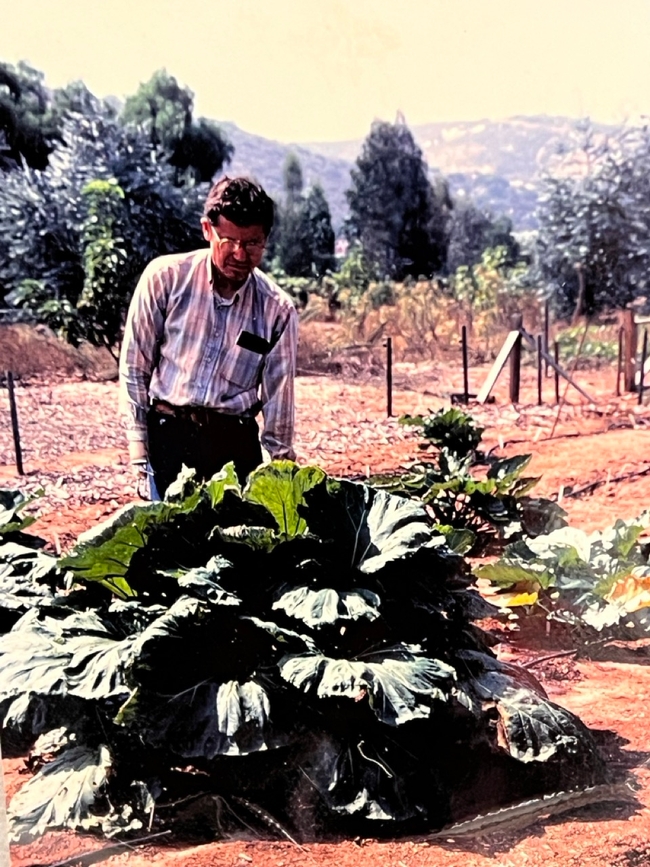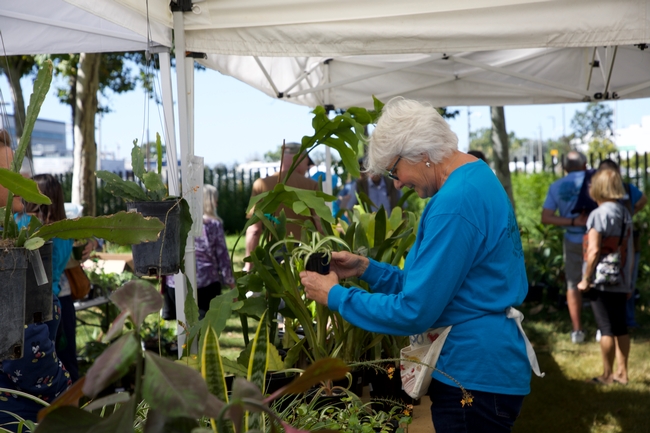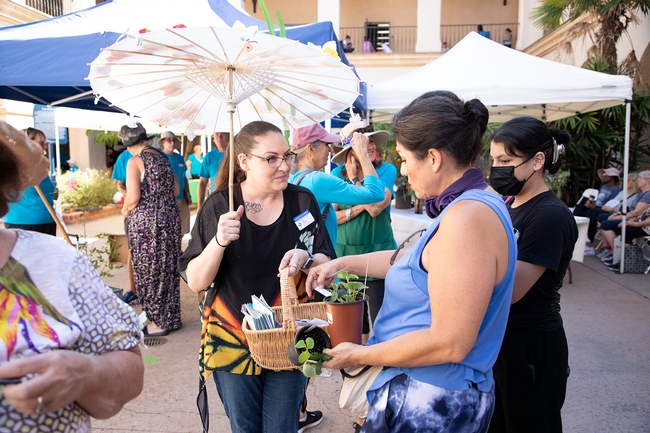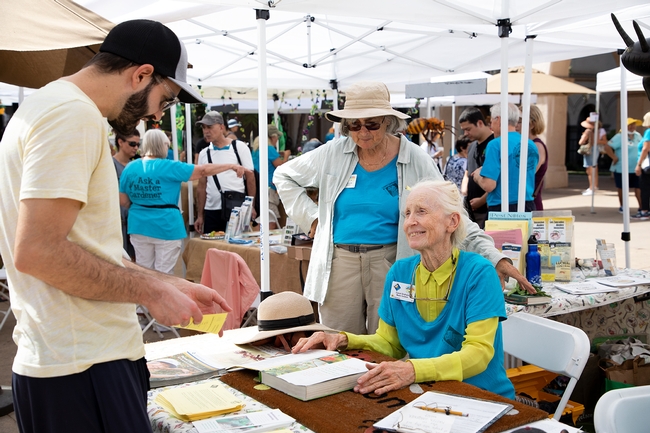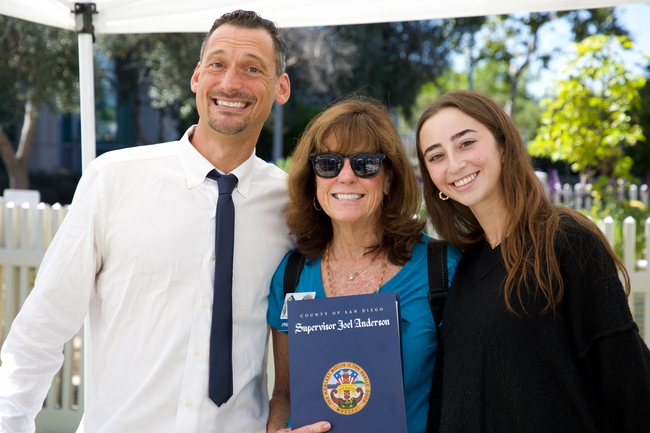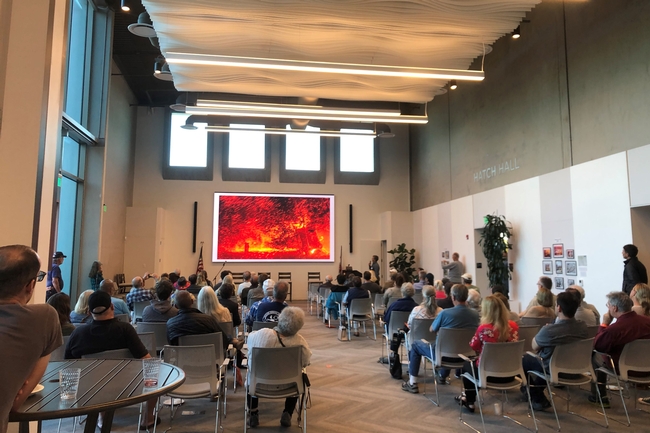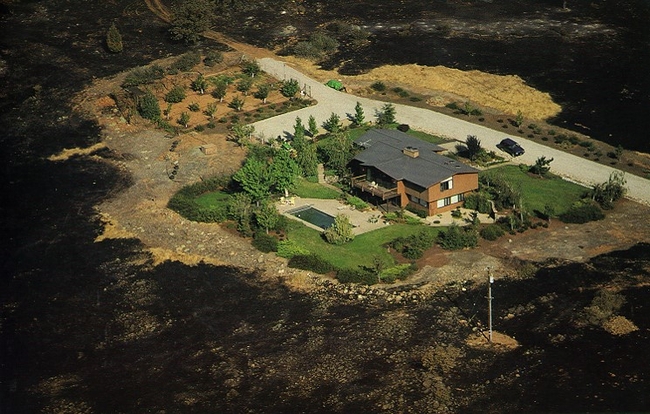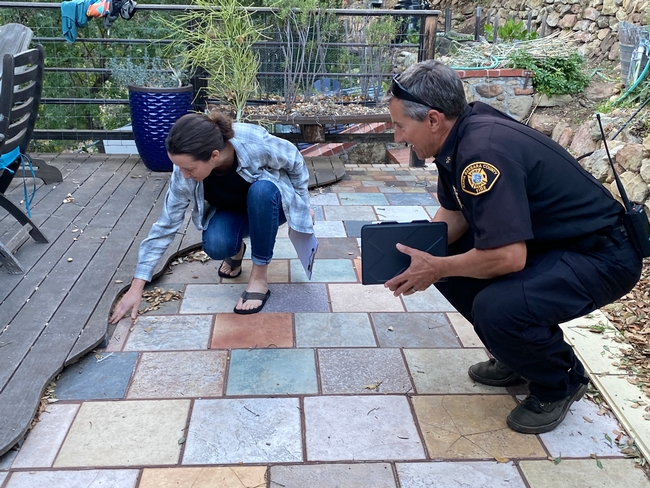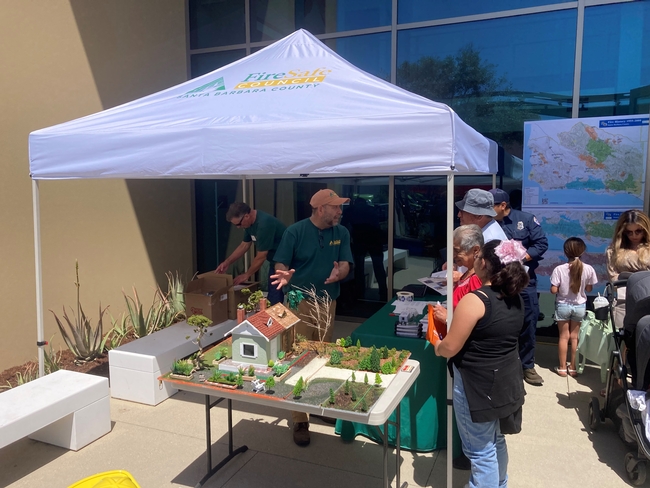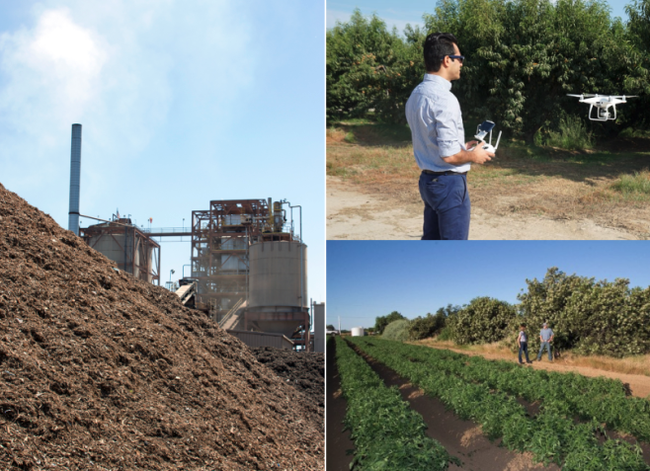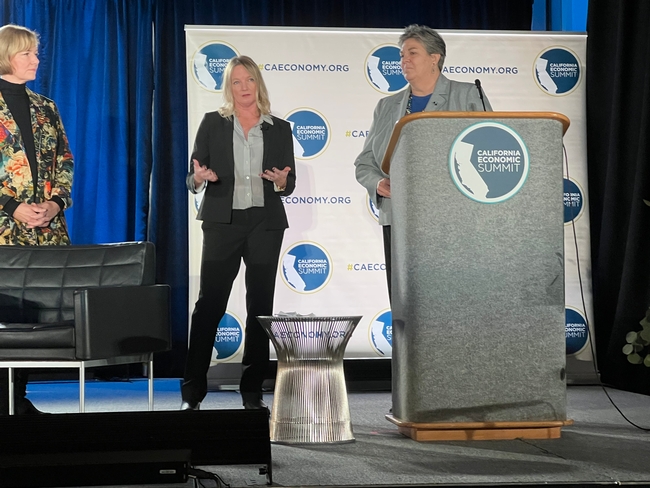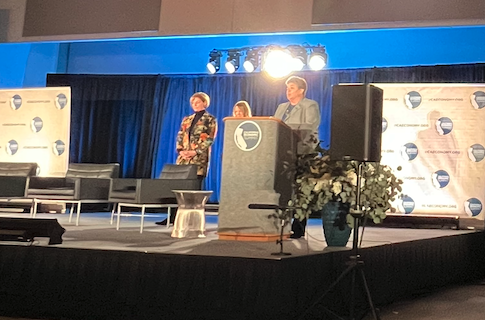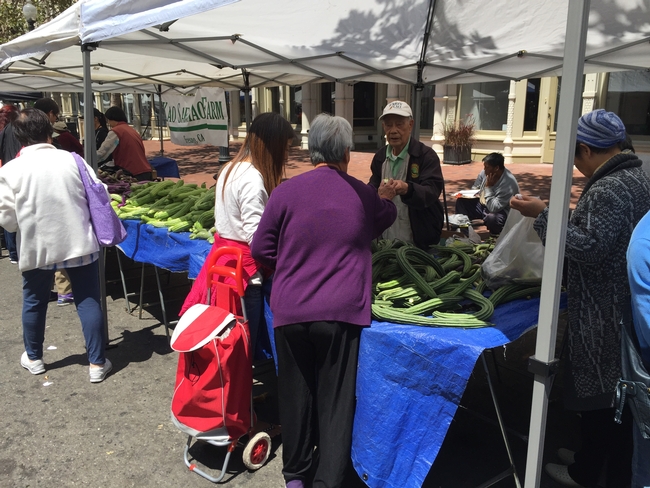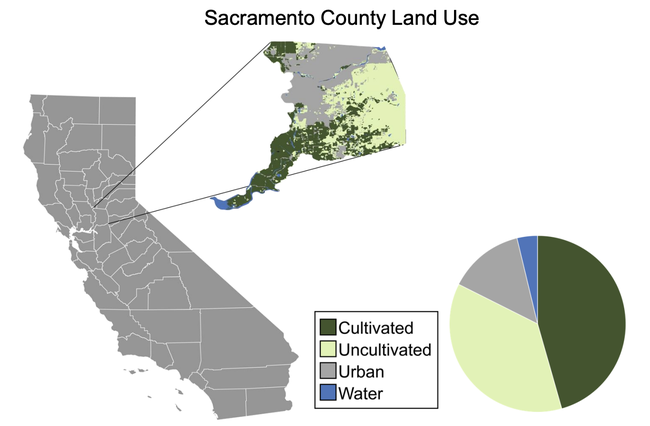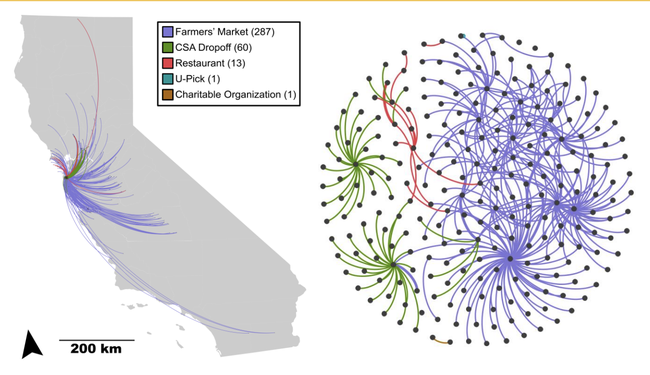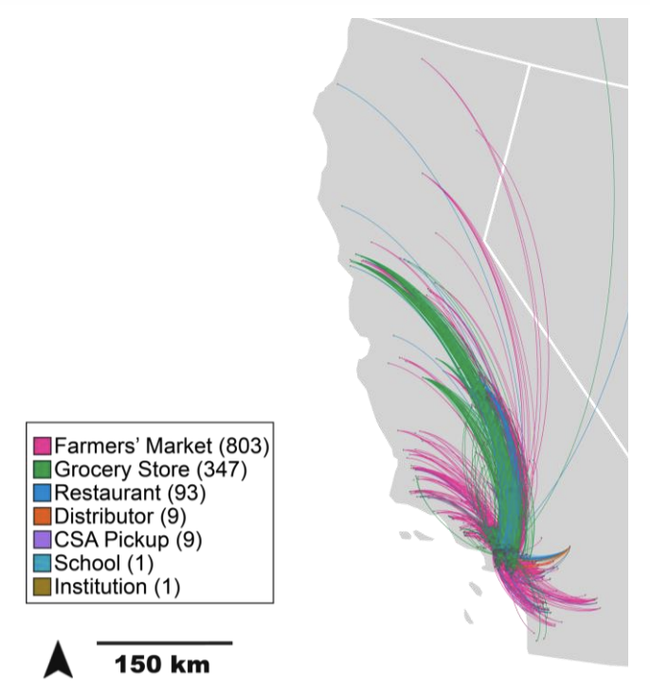
Posts Tagged: community
UC Master Gardeners of San Diego celebrates 40 years of service to community
For 40 years, the University of California Master Gardener Program of San Diego County has upheld its mission of providing research-based information about home horticulture and pest management to the public, while earning and sustaining the community's trust in doing so.
“People trust UC Master Gardeners to provide accurate advice on gardening because they are trained by UC ANR [UC Agriculture and Natural Resources],” said Vincent Lazaneo, emeritus urban horticulture advisor and the first UC Master Gardener program coordinator for San Diego County.
The UC Master Gardener program, a public service and outreach program under UC ANR, is administered by local UC Cooperative Extension offices and outreach is provided by trained volunteers. In 1983, the UC Master Gardener program of San Diego County started with about 30 volunteers. Today, more than 350 volunteers serve the program, which is now managed by program coordinator Leah Taylor.
In San Diego, UC Master Gardeners have had a significant presence in schools, where they encourage an appreciation for plants and our planet; at the county fair where they field hundreds of questions related to plant care; and in community spaces such as Balboa Park and the Carlsbad Flower Fields where they staff demonstration gardens.
“Having the UC behind us is huge,” said Anne Perreira, UC Master Gardener and current president of the Master Gardener Association of San Diego County. “It opens doors for us and gives us credibility.”
'Dual citizenship' status expands capacity for support
When Lazaneo started the UC Master Gardener program in 1983, he felt the need to establish a formal association or 501(c)(3) nonprofit organization that would support the program.
Unsure of what the future held, Lazaneo believed that nonprofit status would increase the UC Master Gardeners' flexibility regarding project development, community engagement and financial planning. After 10 years, the UC Master Gardeners of San Diego County were approved as a registered nonprofit organization and became simultaneously known as the Master Gardener Association of San Diego County.
“It can be confusing for people when they hear that we're a UC program and an association,” explained Taylor. “It's like ‘dual citizenship' in a way, and I think the most important thing to know is that our status as a nonprofit and affiliation to UC work in conjunction to not only support the UC Master Gardeners and what they do in San Diego, but their ability to support UC Master Gardener programs in other counties.”
Emphasizing the research-based approach
Taylor, who has been the program coordinator since 2021, said that the UC Master Gardener program is instrumental in extending the work of UCCE advisors. “If you're working on research and you need to get that information out into the public, we've got 350 UC Master Gardeners who are trained and available to communicate on your behalf,” Taylor said.
“For me it's like a multiplier effect: how many San Diegans can I reach by teaching a seminar on small-scale hydroponics? Maybe 20 or 30,” said Gerry Spinelli, UC Cooperative Extension production horticulture advisor for San Diego County. “But how many can I reach by training 20 or 30 UC Master Gardener volunteers on the same topic? Maybe 200 or 300.”
Spinelli, who also advises the UC Master Gardeners for San Diego County, said that the group has been instrumental in data collection and disseminating information to the public, particularly in urban underserved areas.
Lazaneo recalls the UC Master Gardeners establishing a partnership in 1983 with Cuyamaca College in El Cajon. The college's Horticulture Department allowed the UC Master Gardeners to develop a research garden on campus. After setting a perimeter, building a fence, installing irrigation lines and rototilling the soil, the UC Master Gardeners planted different tomato varieties that were used in a statewide study assessing plant performance for home gardens.
In addition to educating and equipping the public, the UC Master Gardeners of San Diego County have contributed to research efforts on specific crops, including the development of a new artichoke variety, Imperial Star, with guidance from Wayne Schrader, former UCCE vegetable crops advisor for San Diego County.
The research garden, which was used for more than a decade, also aided in research efforts evaluating asparagus varieties, horned cucumbers called “Kiwano,” a fruit similar to melon called pepino dulce, sweet peas, rhubarb and many others. Similarly, the research garden has contributed to trials for soil solarization and chemical treatment to control root knot nematodes and expanded understanding of powdery mildew's impact on summer squash.
Evolving with the times
Out of 170 applications, Lazaneo selected about 30 individuals to be a part of the first class of UC Master Gardeners for San Diego County. Carol Graham, who is still active today, was in the original cohort that formed in 1983.
Graham said that “times have certainly changed,” and one of the changes she's noticed since joining UC Master Gardeners is the proliferation of insects. “I don't remember pests being a severe issue when I first started. Now, you've got all kinds of bugs that have moved into the county, causing people to overuse and misuse pesticides,” said Graham.
Graham's 40 years as a UC Master Gardener have given her an opportunity to teach people how to overcome their phobias of bugs and how to use pesticides safely and appropriately. Furthermore, her role as a UC Master Gardener has allowed her to teach others how to grow their own food in hopes of enhancing food security in the county, something she cares deeply about.
The UC Master Gardeners also have changed the way they communicate over the years. DeLayne Harmon, vice president of member services, is well-versed in the program's history.
“Before we began tracking our volunteer hours online, do you know what the UC Master Gardeners did back in the day?” asked Harmon, who joined UC Master Gardeners in 2020. “They wrote everything down by hand, with pen and paper!”
“It's easy to have the mentality that's like, ‘This is how we've always done things,'” said Harmon. “But the UC Master Gardeners know that there is always room for improvement, and we welcome opportunities to be better.”
Giving back and putting people first
The UC Master Gardeners of San Diego County are eager to improve access to fresh food in schools. Recently, the UC Master Gardeners were given a $5,000 grant by the Sage Garden Project, which will be used to partner with schools in under-resourced communities.
“We want to be in places where the people don't know about UC Master Gardeners,” said Perreira, the association president. “We realized that there are a lot of students who don't know what fresh food looks like and we want to change that.”
In 2022, the UC Master Gardeners transformed a landfill into a demonstration garden, now called the Paradise Hills Native Garden, which they also maintain. “It's beautiful and there are walking trails for the community to enjoy,” Taylor said. “The native garden is in a neighborhood that doesn't have a lot of green space, and to have something so beautiful, that encourages community gatherings, it's a good thing.”
Looking to the future of the UC Master Gardener program in San Diego, Taylor says that she wants to continue making an impact in the community and having the UC Master Gardeners be that driving force.
Grateful for Taylor's leadership, Spinelli said that he is excited about the program's impact on food education, particularly in food deserts.
“We are blessed with a climate that allows year-round food production, and with the science-based knowledge offered by the UC system, our UC Master Gardeners can provide San Diego County residents with the tools to grow local, healthy, nutritious, safe and environmentally friendly food for their families,” Spinelli said.
When reflecting on how far the UC Master Gardeners of San Diego County have come, Perreira – who has been a UC Master Gardener since 2016 – emphasized how important it is to continue their legacy of doing good in and with the community. “We've got a diversity of skills within our group and I'm ready for us to expand our capacity to create change. What we do and what we say have to mean something!” she said.
To read this story in Spanish, visit: https://ucanr.edu/blogs/blogcore/postdetail.cfm?postnum=59028
Congrats to Outstanding Advisor and Mentor Louie Yang!
Congratulations to community ecologist Louie Yang, a UC Davis professor in the Department of Entomology and Nematology and chair of the Entomology Graduate Program, He is one of 33 recipients of the 2023 UC Davis Graduate Program Advising and Mentoring Awards. "Your program...
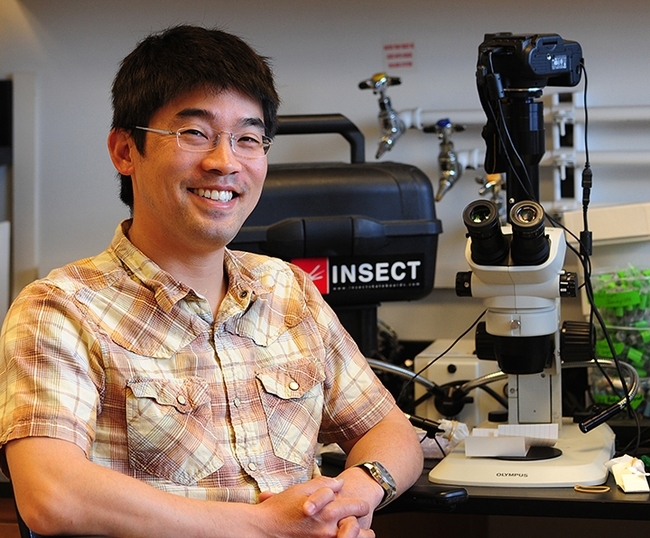
Community ecologist Louie Yang, professor, UC Davis Department of Entomology and Nematology, has received a campuswide UC Davis Graduate Program Advising and Mentoring Award. (Photo by Kathy Keatley Garvey)
Study: Regional approach to wildfire more comprehensive, equitable
Pilot program in Santa Barbara County shows promise for bolstering resilience
After a rash of wildfires across Southern California in 2003, many counties, cities and neighborhoods adopted Community Wildfire Protection Plans to improve their preparedness and fire response. But Rob Hazard, fire marshal for Santa Barbara County, has noticed that CWPPs and resources are unevenly distributed across areas at high risk of wildfire.
“Communities that are more affluent, more white, they are the ones that end up getting the grants, they're the ones that end up getting the projects to mitigate risks,” Hazard said, “whereas more disadvantaged communities…often don't have the organization to make that happen, or maybe it's not the most pressing issue of the moment.”
Mapping those underserved communities – and ensuring they have a more equitable share of attention – are some of the goals of a new, more comprehensive approach to wildfire, currently being piloted in Santa Barbara County. This “Regional Wildfire Mitigation Program” aims to fill in many of the gaps left by CWPPs, which tend to have a more narrow focus on fuel reductions for a specific locality.
“They certainly have their role and benefits, but CWPPs are pretty limited in scope,” said Max Moritz, University of California Cooperative Extension's statewide wildfire specialist. “They're really focused on modeling and prioritizing fuel breaks, and they leave all of these other aspects of our fire problem – our vulnerabilities, our potential losses – unaddressed.”
Moritz is the lead author of a recently published research article that describes the Regional Wildfire Mitigation Program's three key areas (or “domains”) for wildfire mitigation work: the built environment (pinpointing and addressing needs in buildings/infrastructure), landscape (creating buffers through land use policies and management choices), and community (educating the public on home hardening and other issues).
“It's this holistic approach that combines all of these elements, and each one of those elements speak to each other – they can't be independent,” said Hazard, a study co-author.
Seeking a better way
After the Thomas Fire devastated the region in 2017-18 and triggered deadly mudslides in Montecito, Moritz – an adjunct professor at UC Santa Barbara's Bren School of Environmental Science & Management – sought more encompassing risk mapping and mitigation solutions that could complement CWPP efforts.
He got together with Hazard, who began his career as a “hotshot crew” firefighter with the U.S. Forest Service and has been with Santa Barbara County Fire Department for nearly 25 years.
“Both of us believe: Yes, it is home hardening – but it's also defensible space, but it's also some fuel treatments, but it's also some prescribed fire, but it's also some agricultural belt (to create a buffer),” said Hazard. “We looked at it objectively, and in every community in Santa Barbara County there's something that either works – or doesn't.”
By the end of the pilot program along the south coast of Santa Barbara County, the team hopes to have refined a “decision support system” that other communities across the state – and perhaps around the globe – could use. The framework would incorporate their localized risk assessment data and conditions to help generate lists of prioritized projects across the three “domains” of wildfire mitigation.
The ability to adapt to new data and continual changes in ecosystems, communities and climate is another advantage of the RWMP. Unlike a “plan” that tends to be a one-off with a defined start and end date, this wildfire mitigation “program” is designed to pivot and evolve as conditions change. The goal is to motivate and guide implementation of risk mitigation activities in each domain.
“The program is a living program, so it's not going to be some PDF that sits on a server somewhere,” Hazard said.
One of the early lessons from the RWMP pilot has been that – aside from funding – a crucial factor in maintaining the momentum of a wildfire mitigation program is the presence of a dedicated group of community members.
“In each community, we'll need a group that is ready to take this on and spearhead it and run with it,” Moritz said. “In many communities, that will probably be the Fire Safe Council.”
Building ‘Firewise' communities
Local Fire Safe Councils are “grassroots, community-led organizations that mobilize residents to protect their homes, communities and environments from catastrophic wildfire,” according to the California Fire Safe Council.
And while Moritz, Hazard and other experts serve on the volunteer Board of Directors for Santa Barbara County Fire Safe Council, they soon realized that they needed to hire staff to perform the “community domain” work of educating and reaching out to residents.
A $5 million grant from the National Fish and Wildlife Foundation for the RWMP project helped build the capacity of the council, which hired its first staff member, Anne-Marie Parkinson, last fall.
“A lot of people underestimate how important it is to have community activists or leaders who take on the role and responsibility of organizing people, being the point of contact, rallying people to do activities or work days,” said Parkinson, a graduate of UCSB's Bren School and a co-author of the RWMP study.
Parkinson has been working to get communities recognized by Firewise USA, a program of the National Fire Protection Association to organize residents in bolstering wildfire preparedness and reducing risk.
Although she has been encouraged by the awareness and activism among the community members she has met, Parkinson also hears from residents about the need for more resilient power and communications networks – concerns that could be better addressed by consolidating those requests with a regional approach.
“As we work with more and more communities, you can start to map which communities want better telecommunications, and which communities would benefit from a fuel break around them, and then we could write a grant that benefits five communities, instead of one small grant for one community,” Parkinson said.
Moving forward
There are many communities in fire-prone environments that are in need of help, and climate change makes their situation increasingly urgent, Moritz said, and a new and comprehensive framework – the RWMP – now exists for assessing and mitigating multiple risks.
“Every community has its own unique fire hazards and its own unique spatial layout of neighborhoods and vulnerabilities inherent to those neighborhoods,” he said. “But despite the uniqueness of each community and each region, I'm hoping this will provide a somewhat systematic way to approach making progress and mitigating a whole suite of risks.”
Other authors of the article are Kelly Johnston, Molly Mowery and Katie Oran of the Community Wildfire Planning Center; Marc Mayes of Spatial Informatics Group-Natural Assets Lab and UC Santa Barbara Earth Research Institute; Graham Wesolowski of Spatial Informatics Group-Natural Assets Lab; and David Schmidt of Spatial Informatics Group. The article is published in Frontiers in Forests and Global Change at https://www.frontiersin.org/articles/10.3389/ffgc.2022.848254/full.
People interested in learning more about the RWMP approach are encouraged to contact Graham Wesolowski at gwesolowski@sig-nal.org or Max Moritz at mmoritz@bren.ucsb.edu.
To jump-start local economies, UC ANR partners with California Stewardship Network
The University of California Agriculture and Natural Resources is pleased to announce a new partnership with the California Stewardship Network to accelerate economic recovery across the state by tapping expertise in broadband development, small-business acumen, agricultural technology and more.
To help communities recover from the recession and expand regional economic-development efforts, UC ANR is investing approximately $3 million to hire 15 new UC Cooperative Extension (UCCE) advisors and one specialist. These UCCE experts will collaborate closely with members of the California Stewardship Network – an alliance of regional leaders who are committed to solving state's most pressing economic, environmental and social well-being challenges.
“The California Stewardship Network represents regions across California and each region is different, with its own challenges and opportunities. This UCCE investment brings science and solutions that fit the uniqueness of each region, while partnering across the state to improve our communities,” said Heidi Hill Drum, co-chair of the California Stewardship Network and CEO of the Tahoe Prosperity Center.
The UCCE scientists will leverage existing community and economic development efforts, especially in rural parts of the state, and provide vital expertise in business development, agricultural technology, biomass and wood products, disaster recovery, water justice, controlled environment food production, food systems development, urban resiliency and – crucially – digital infrastructure.
“We've long known how important it was to close the digital divide, but COVID really highlighted the absolutely critical need for all families and communities to have high-quality access to the internet,” said Glenda Humiston, University of California vice president for agriculture and natural resources.
In rural regions of the state, the pandemic, catastrophic wildfires and increased global competition have been whittling away at rural economies. The “working landscapes” of wilderness areas, farms and ranches provide food as well as wildlife habitat, recreational venues, energy and water. Humiston sees vital opportunities to expand revenue in these areas for rural residents.
“For California to thrive, these working landscapes must be managed to yield economic opportunities now and into the future,” Humiston said.
“California needs healthier forests for many reasons – reduced risk from wildfire, producing more water, better habitat and recreation opportunities – but we will not get there if we can't develop valuable uses for the excess biomass that needs to be removed from our forests.”
Hiring is underway for some of the new UC Cooperative Extension positions; others will be released for recruitment in early 2022. The 16 new UCCE positions and the counties they serve include the following:
1. Rural Community and Economic Development Area Advisor (Del Norte, Humboldt, and Trinity)
2. Agricultural Technology (Intermountain Research and Extension Center in Siskiyou County)
3. Biomass and Forest Products Advisor (Siskiyou, Shasta and Trinity)
4. Broadband Development Area Advisor (Butte, Tehama, Glenn)
5. Disaster Recovery for Housing (Plumas, Lassen, Sierra)
6. Water Justice Policy and Planning Specialist (UC Berkeley)
7. Regional Food Systems Area Advisor (Sacramento, Placer, Yolo, Solano)
8. Regional Food Systems Area Advisor (Amador, El Dorado, Calaveras, Tuolumne)
9. Woody Biomass and Forest Products Advisor, (El Dorado, Alpine, Amador, Calaveras, Tuolumne, and Mariposa)
10. Agriculture Technology Area Advisor, (Monterey, Santa Cruz, San Benito, San Luis Obispo)
11. Technology and Innovation for Small Farms Advisor, (Kearney Agricultural Research and Extension Center in Fresno County)
12. Community and Economic Development Area Advisor, (Inyo, Mono, Northeastern Kern)
13. Water and Community Resilience Area Advisor, (Kern, Kings, Tulare)
14. Community and Economic Development Area Advisor – (Los Angeles, Orange)
15. Woody Biomass and Bioenergy Advisor, (Riverside, San Bernardino)
16. Agriculture Technology Area Advisor, (South Coast Research and Extension Center in Orange County)
To connect more farmers with buyers, UC publishes community food guides
Over the past year, many farmers have had to navigate rapid shifts in marketing practices since the COVID-19 pandemic disrupted traditional food-supply systems. During this time, establishing relationships with local vendors has become necessary for growers to maintain and increase profits.
To create a more connected and sustainable environment for local farms and markets, it has become crucial to understand the network of growers and identify critical gaps and central hubs in regional food systems, according to University of California Center for Regional Change Director Catherine Brinkley.
To help farmers establish connections with restaurants and produce sellers, Brinkley has created online resources for markets and farmers to identify opportunities to build relationships with local vendors in Los Angeles, San Francisco, Santa Clara and Yolo counties – and, most recently, in Sacramento, Placer and El Dorado counties.
Creating direct relationships with vendors is key in areas such as Sacramento County, home to California's capitol, one of the nation's highest producing agricultural counties, and rising rates of food insecurity.
“To draw attention to the transparent marketing connections between farms and markets in the county, we gathered online information about farms that advertise where their products can be found and the markets that advertise which farms they support,” said Brinkley.
With support from the Sacramento Region Community Foundation, Valley Vision, a regional nonprofit, is coordinating efforts to update the Sacramento Regional Food System Action Plan, which covers El Dorado, Placer, Yolo and Sacramento counties. Brinkley's guides are assisting in this effort to understand how the regional food system is changing and connecting with growers and consumers.
Similarly, Brinkley's team has helped Santa Clara County's efforts to create a food plan by supplying a community food guide and farmland mapping.
Often, farmers connect directly with community members at farmers markets, through community supported agriculture (CSAs), and form relationships with buyers at local restaurants and institutions committed to supporting the community's combined needs for a healthy diet, soils and development. By building a community food system, Brinkley hopes farming practices and consumer needs will become more transparent and adjust to help better meet the needs of ecosystems, farmers, farm workers and consumers.
Establishing a more integrated and complex community food system could benefit the community beyond growers and markets, generating regional pride and mutual support. By proudly showcasing the farms and markets that sell or donate food to them, farmers markets, grocery stores and restaurants could build trust in the food system – and boost name recognition for many of the contributors.
“It is our hope that this research will encourage farmers, vendors and those within the community to create connections and utilize their purchasing power in ways that will support their local agricultural community,” said Brinkley. “Building coalitions of growers and sellers can help promote sustainable farming practices within the area, which support farm workers, the environment and fellow consumers.”
Brinkley's team also highlights avenues for building greater equity into the food system with a focus on self-identified growers and market managers of color as well as where farms and markets donate to food banks and seek to alleviate food insecurity.
The online publications developed for Sacramento, El Dorado, Yolo and Placer counties includes mapping of transparent market connections, a food system assessment to help understand how the many farms and markets are connected, which markets are essential to the network, and which types of marketing practices are dominant within these counties.
The guides are produced in partnership with UC Agriculture and Natural Resources, Community Alliance with Family Farmers, the Edible Schoolyard Project, Valley Vision and the California Alliance of Farmers Markets.
Brinkley intends to produce guides for all 58 California counties. “Community Food Guides” for El Dorado, Placer, Los Angeles, Sacramento, San Francisco, Santa Clara and Yolo counties can be downloaded for free at https://brinkley.faculty.ucdavis.edu/home/research/california-county-community-food-guides

